Facile Fabrication of Highly Active Magnetic Aminoclay Supported Palladium Nanoparticles for the Room Temperature Catalytic Reduction of Nitrophenol and Nitroanilines
Abstract
1. Introduction
2. Results and Discussion
2.1. Characterization of AC@Fe3O4@Pd
2.2. Catalytic Activity
3. Materials and Methods
3.1. Chemicals
3.2. Preparation of Aminoclay (AC)
3.3. Preparation of AC@Fe3O4 Composites
3.4. Preparation of AC@Fe3O4@Pd Composites
3.5. Characterizations
3.6. Catalytic Studies
4. Conclusions
Author Contributions
Acknowledgments
Conflicts of Interest
References
- Arrigo, R.; Wrabetz, S.; Schuster, M.E.; Wang, D.; Villa, A.; Rosenthal, D.; Girsgdies, F.; Weinberg, G.; Prati, L.; Schlögl, R.; et al. Tailoring the morphology of Pd nanoparticles on CNTs by nitrogen and oxygen functionalization. Phys. Chem. Chem. Phys. 2012, 14, 10523–10532. [Google Scholar] [CrossRef] [PubMed]
- Guo, X.F.; Jang, D.Y.; Jang, H.G.; Kim, G.J. Hydrogenation and dehydrogenation reactions catalyzed by CNTs supported palladium catalysts. Catal. Today 2012, 186, 109–114. [Google Scholar] [CrossRef]
- Weerachawanasak, P.; Mekasuwandumrong, O.; Arai, M.; Fujita, S.I.; Praserthdam, P.; Panpranot, J. Effect of strong metal–support interaction on the catalytic performance of Pd/TiO2 in the liquid-phase semihydrogenation of phenylacetylene. J. Catal. 2009, 262, 199–205. [Google Scholar] [CrossRef]
- Coker, V.S.; Bennett, J.A.; Telling, N.D.; Henkel, T.; Charnock, J.M.; van der Laan, G.; Pattrick, R.A.; Pearce, C.I.; Cutting, R.S.; Shannon, I.J.; et al. Microbial engineering of nanoheterostructures: Biological synthesis of a magnetically recoverable palladium nanocatalyst. ACS Nano 2010, 4, 2577–2584. [Google Scholar] [CrossRef] [PubMed]
- Hong, Q.; Yu, S.; Yang, Y.; Liu, G.; Shao, Z. A polymorphism in JMJD2C alters the cleavage by caspase-3 and the prognosis of human breast cancer. Oncotarget 2014, 5, 4779–4787. [Google Scholar] [CrossRef] [PubMed]
- Hyotanishi, M.; Isomura, Y.; Yamamoto, H.; Kawasaki, H.; Obora, Y. Surfactant-free synthesis of palladium nanoclusters for their use in catalytic cross-coupling reactions. Chem. Commun. 2011, 47, 5750–5752. [Google Scholar] [CrossRef] [PubMed]
- Chen, Z.; Cui, Z.M.; Niu, F.; Jiang, L.; Song, W.G. Pd nanoparticles in silica hollow spheres with mesoporous walls: A nanoreactor with extremely high activity. Chem. Commun. 2010, 46, 6524–6526. [Google Scholar] [CrossRef] [PubMed]
- Jia, L.; Zhou, T.; Xu, J.; Xu, Z.; Li, H.; Liu, B.; Sun, J.; Cao, J.; Shen, X.; Li, X. Synthesis and characterization of PdRu alloy-coated palygorskite-based nanocomposites as a magnetically recyclable multifunctional catalyst for reduction of nitroarenes and azo dyes. Mater. Lett. 2017, 197, 24–27. [Google Scholar] [CrossRef]
- Yamada, Y.M.A.; Yuyama, Y.; Sato, T.; Fujikawa, S.; Uozumi, Y. A palladium-nanoparticle and silicon-nanowire-array hybrid: A platform for catalytic heterogeneous reactions. Angew. Chem. Int. Ed. 2014, 53, 127–131. [Google Scholar] [CrossRef] [PubMed]
- Yang, X.L.; Zhong, H.; Zhu, Y.H.; Jiang, H.L.; Shen, J.H.; Huang, J.F.; Li, C.Z. Highly efficient reusable catalyst based on silicon nanowire arrays decorated with copper nanoparticles. J. Mater. Chem. A 2014, 2, 9040–9047. [Google Scholar] [CrossRef]
- Wang, C.; Salmon, L.; Ciganda, R.; Yate, L.; Moya, S.; Ruiz, J.; Astruc, D. An efficient parts-per-million a-Fe2O3 nanocluster/graphene oxide catalyst for Suzuki–Miyaura coupling reactions and 4-nitrophenol reduction in aqueous solution. Chem. Commun. 2017, 53, 644–646. [Google Scholar] [CrossRef] [PubMed]
- Jia, L.; Zhou, T.; Xu, J.; Li, F.; Xu, Z.; Zhang, W.; Guo, S.; Shen, X.; Zhang, B. AuPd bimetallic nanocrystals embedded in magnetic halloysite nanotubes: Facile synthesis and catalytic reduction of nitroaromatic compounds. Nanomaterials 2017, 7, 333. [Google Scholar] [CrossRef] [PubMed]
- Yan, Y.; Miao, J.; Yang, Z.; Xiao, F.X.; Yang, H.B.; Liu, B.; Yang, Y. Carbon nanotube catalysts: Recent advances in synthesis, characterization and applications. Chem. Soc. Rev. 2015, 44, 3295–3346. [Google Scholar] [CrossRef] [PubMed]
- Cai, R.; Ellis, P.R.; Yin, J.; Liu, J.; Brown, C.M.; Griffin, R.; Chang, G.; Yang, D.; Ren, J.; Cooke, K.; et al. Performance of preformed Au/Cu nanoclusters deposited on mgo powders in the catalytic reduction of 4-nitrophenol in solution. Small 2018, 14, 1703734. [Google Scholar] [CrossRef] [PubMed]
- Bao, Z.; Yuan, Y.; Leng, C.; Li, L.; Zhao, K.; Sun, Z. One-pot synthesis of noble metal/zinc oxide composites with controllable morphology and high catalytic performance. ACS Appl. Mater. Interfaces 2017, 9, 16417–16425. [Google Scholar] [CrossRef] [PubMed]
- Wang, C.Y.; Boucher, M.; Yang, M.; Saltsburg, H.; Flytzani-Stephanopoulos, M. ZnO-modified zirconia as gold catalyst support for the low-temperature methanol steam reforming reaction. Appl. Catal. B 2014, 154–155, 142–152. [Google Scholar] [CrossRef]
- Wu, Y.; Wang, D.; Zhao, P.; Niu, Z.; Peng, Q.; Li, Y. Monodispersed Pd–Ni nanoparticles: Composition control synthesis and catalytic properties in the Miyaura–Suzuki reaction. Inorg. Chem. 2011, 50, 2046–2048. [Google Scholar] [CrossRef] [PubMed]
- Bychkov, V.Y.; Tyulenin, Y.P.; Gorenberg, A.Y.; Sokolov, S.; Korchak, V. Evolution of Pd catalyst structure and activity during catalytic oxidation of methane and ethane. Appl. Catal. A Gen. 2014, 485, 1–9. [Google Scholar] [CrossRef]
- Walker, A.; King, D. Production of synthesis gas by direct catalytic oxidation of methane on Pt{110} (1 × 2) using supersonic molecular beams. J. Phys. Chem. B 2000, 104, 6462–6467. [Google Scholar] [CrossRef]
- Naghipour, A.; Fakhri, A. Heterogeneous Fe3O4@chitosan-Schiff base Pd nanocatalyst: Fabrication, characterization and application as highly efficient and magnetically-recoverable catalyst for Suzuki–Miyaura and Heck–Mizoroki C–C coupling reactions. Catal. Commun. 2016, 73, 39–45. [Google Scholar] [CrossRef]
- Li, Q.F.; Jin, L.; Li, L.; Ma, W.; Wang, Z.; Hao, J. Water-soluble luminescent hybrid aminoclay grafted with lanthanide complexes synthesized by a Michael-like addition reaction and its gas sensing application in PVP nanofiber. J. Mater. Chem. C 2017, 5, 4670–4676. [Google Scholar] [CrossRef]
- Zhao, L.Z.; Zhou, C.H.; Wang, J.; Tong, D.S.; Yu, W.H.; Wang, H. Recent advances in clay mineral-containing nanocomposite hydrogels. Soft Matter 2015, 11, 9229–9246. [Google Scholar] [CrossRef] [PubMed]
- Assadi, A.A.; Bouzaza, A.; Lemasle, M.; Wolbert, D. Removal of trimethylamine and isovaleric acid from gas streams in a continuous flow surface discharge plasma reactor. Chem. Eng. Res. Des. 2015, 93, 640–651. [Google Scholar] [CrossRef]
- Li, Q.F.; Liu, Z.; Jin, Z.; Yang, P.; Wang, Z. A water-soluble fluorescent hybrid material based on aminoclay and its bioimaging application. RSC Adv. 2017, 7, 44614–44618. [Google Scholar] [CrossRef]
- Datta, K.K.R.; Achari, A.; Eswaramoorthy, M. Aminoclay: A functional layered material with multifaceted applications. J. Mater. Chem. A 2013, 1, 6707–6718. [Google Scholar] [CrossRef]
- Hoseini, S.J.; Rashidi, M.; Bahrami, M. Platinum nanostructures at the liquid–liquid interface: Catalytic reduction of p-nitrophenol to p-aminophenol. J. Mater. Chem. 2011, 21, 16170–16176. [Google Scholar] [CrossRef]
- Ravula, S.; Essner, J.B.; La, W.A.; Polo-Parada, L.; Kargupta, R.; Hull, G.J.; Sengupta, S.; Baker, G.A. Sunlight-assisted route to antimicrobial plasmonic aminoclay catalysts. Nanoscale 2015, 7, 86–91. [Google Scholar] [CrossRef] [PubMed]
- Kumar, A.S.; Datta, K.K.R.; Rao, T.S.; Raghavan, K.V.; Eswaramoorthy, M.; Reddy, B.V.S. Pd-aminoclay nanocomposite as an efficient recyclable catalyst for hydrogenation and Suzuki cross coupling reactions. J. Nanosci. Nanotechnol. 2012, 12, 2000–2007. [Google Scholar] [CrossRef] [PubMed]
- White, R.J.; Luque, R.; Budarin, V.L.; Clark, J.H.; Macquarrie, D.J. Supported metal nanoparticles on porous materials. Methods and applications. Chem. Soc. Rev. 2009, 38, 481–494. [Google Scholar] [CrossRef] [PubMed]
- Lee, Y.C.; Park, W.K.; Yang, J.W. Removal of anionic metals by amino-organoclay for water treatment. J. Hazard. Mater. 2011, 190, 652–658. [Google Scholar] [CrossRef] [PubMed]
- Patil, A.J.; Mann, S. Self-assembly of bio-inorganic nanohybrids using organoclay building blocks. J. Mater. Chem. 2008, 18, 4605–4615. [Google Scholar] [CrossRef]
- Wu, G.; Liang, X.; Zhang, L.; Tang, Z.; Almamun, M.; Zhao, H.; Su, X. Fabrication of highly stable metal oxide hollow nanospheres and their catalytic activity toward 4-nitrophenol reduction. ACS Appl. Mater. Interfaces 2017, 9, 18207–18214. [Google Scholar] [CrossRef] [PubMed]
- Kim, T.; Fu, X.; Warther, D.; Sailor, M.J. Size-controlled Pd nanoparticle catalysts prepared by galvanic displacement into a porous Si-Iron oxide nanoparticle host. ACS Nano 2017, 11, 2773–2784. [Google Scholar] [CrossRef] [PubMed]
- Wang, Z.; Su, R.; Wang, D.; Shi, J.; Wang, J.X.; Pu, Y.; Chen, J.F. Sulfurized graphene as efficient metal-free catalysts for reduction of 4-nitrophenol to 4-aminophenol. Ind. Eng. Chem. Res. 2017, 56, 13610–13617. [Google Scholar] [CrossRef]
- Jin, Z.; Xiao, M.D.; Bao, Z.H.; Wang, P.; Wang, J.F. A general approach to mesoporous metal oxide microspheres loaded with noble metal nanoparticles. Angew. Chem. Int. Ed. 2012, 51, 6406–6410. [Google Scholar] [CrossRef] [PubMed]
- Gu, X.M.; Qi, W.; Xu, X.Z.; Sun, Z.H.; Zhang, L.Y.; Liu, W.; Pan, X.L.; Su, D.S. Covalently functionalized carbon nanotube supported Pd nanoparticles for catalytic reduction of 4-nitrophenol. Nanoscale 2014, 6, 6609–6616. [Google Scholar] [CrossRef] [PubMed]
- Dutta, S.; Sarkar, S.; Ray, C.; Roy, A.; Sahoo, R.; Pal, T. Mesoporous gold and palladium nanoleaves from liquid–liquid interface: Enhanced catalytic activity of the palladium analogue toward hydrazine-assisted room-temperature 4-nitrophenol reduction. ACS Appl. Mater. Interfaces 2014, 6, 9134–9143. [Google Scholar] [CrossRef] [PubMed]
- Wang, Z.M.; Xu, C.L.; Gao, G.Q.; Li, X. Facile synthesis of well-dispersed Pd-graphene nanohybrids and their catalytic properties in 4-nitrophenol reduction. RSC Adv. 2014, 4, 13644–13651. [Google Scholar] [CrossRef]
- Bramhaiah, K.; John, N.S. Hybrid films of reduced graphene oxide with noble metal nanoparticles generated at a liquid/liquid interface for applications in catalysis. RSC Adv. 2013, 3, 7765–7773. [Google Scholar] [CrossRef]
- Yao, T.J.; Cui, T.Y.; Fang, X.; Cui, F.; Wu, J. Preparation of yolk-shell FexOy/Pd@mesoporous SiO2 composites with high stability and their application in catalytic reduction of 4-nitrophenol. Nanoscale 2013, 5, 5896–5904. [Google Scholar] [CrossRef] [PubMed]
- Liu, J.; Huo, X.; Li, T.R.; Yang, Z.Y.; Xi, P.X.; Wang, Z.Y.; Wang, B.D. Palladium nanoparticles bonded to two-dimensional iron oxide graphene nanosheets: A synergistic and highly reusable catalyst for the Tsuji-Trost reaction in water and air. Chem. Eur. J. 2014, 20, 11549–11555. [Google Scholar] [CrossRef] [PubMed]
- Chen, Z.; Cui, Z.M.; Li, P.; Cao, C.Y.; Hong, Y.L.; Wu, Z.Y.; Song, W.G. Diffusion induced reactant shape selectivity inside mesoporous pores of Pd@meso-SiO2 nanoreactor in Suzuki coupling reactions. J. Phys. Chem. C 2012, 116, 14986–14991. [Google Scholar] [CrossRef]
- Sheng, J.; Wang, L.; Deng, L.; Zhang, M.; He, H.; Zeng, K.; Tang, F.; Liu, Y.N. MOF-templated fabrication of hollow Co4N@N-doped carbon porous nanocages with superior catalytic activity. ACS Appl. Mater. Interfaces 2018, 10, 7191–7200. [Google Scholar] [CrossRef] [PubMed]
- Lee, Y.C.; Lee, H.U.; Lee, K.; Kim, B.; Lee, S.Y.; Choi, M.H.; Farooq, W.; Choi, J.S.; Park, J.Y.; Lee, J.; et al. Aminoclay-conjugated TiO2 synthesis for simultaneous harvesting and wet-disruption of oleaginous Chlorella sp. Chem. Eng. J. 2014, 245, 143–149. [Google Scholar] [CrossRef]
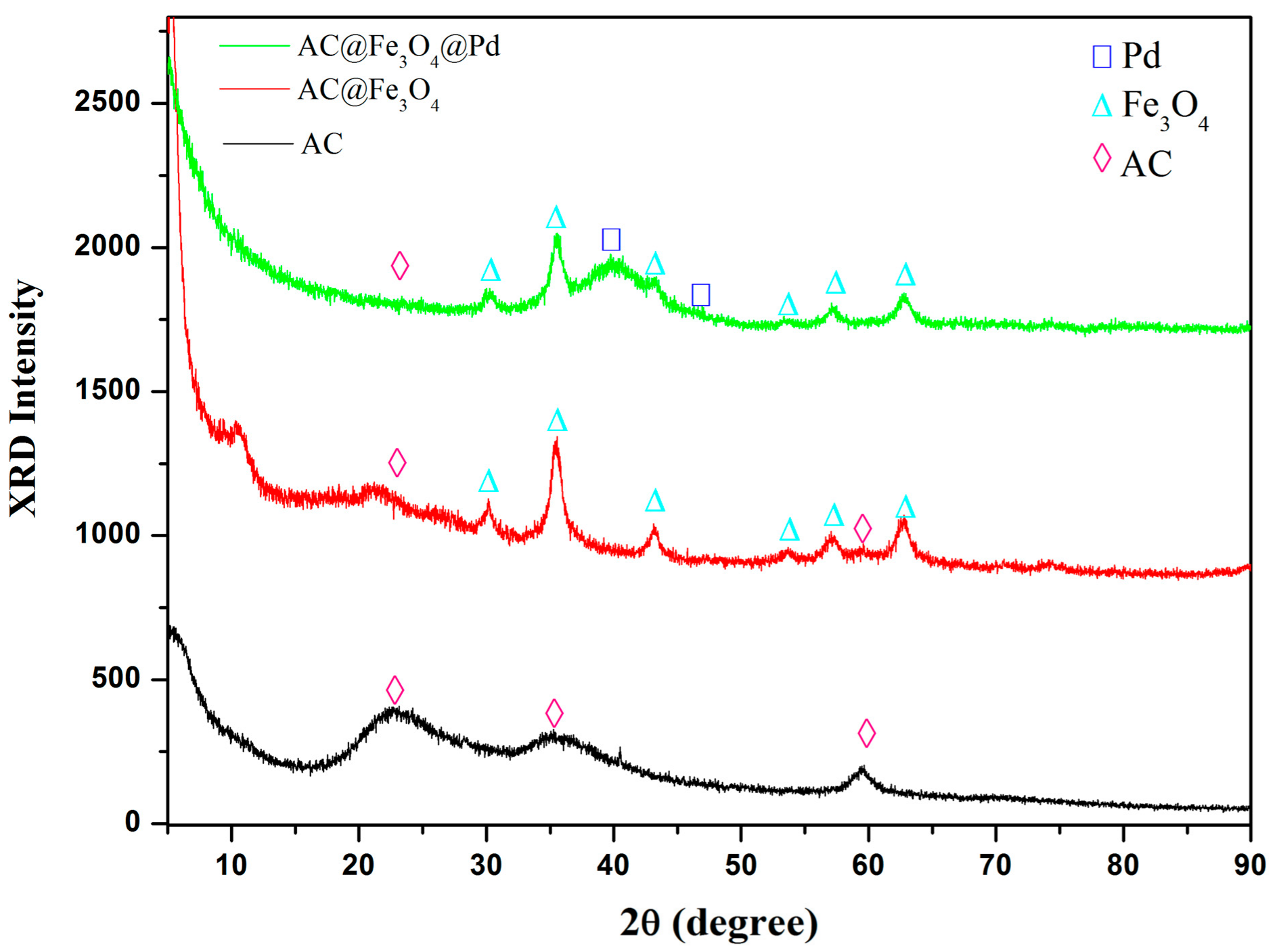
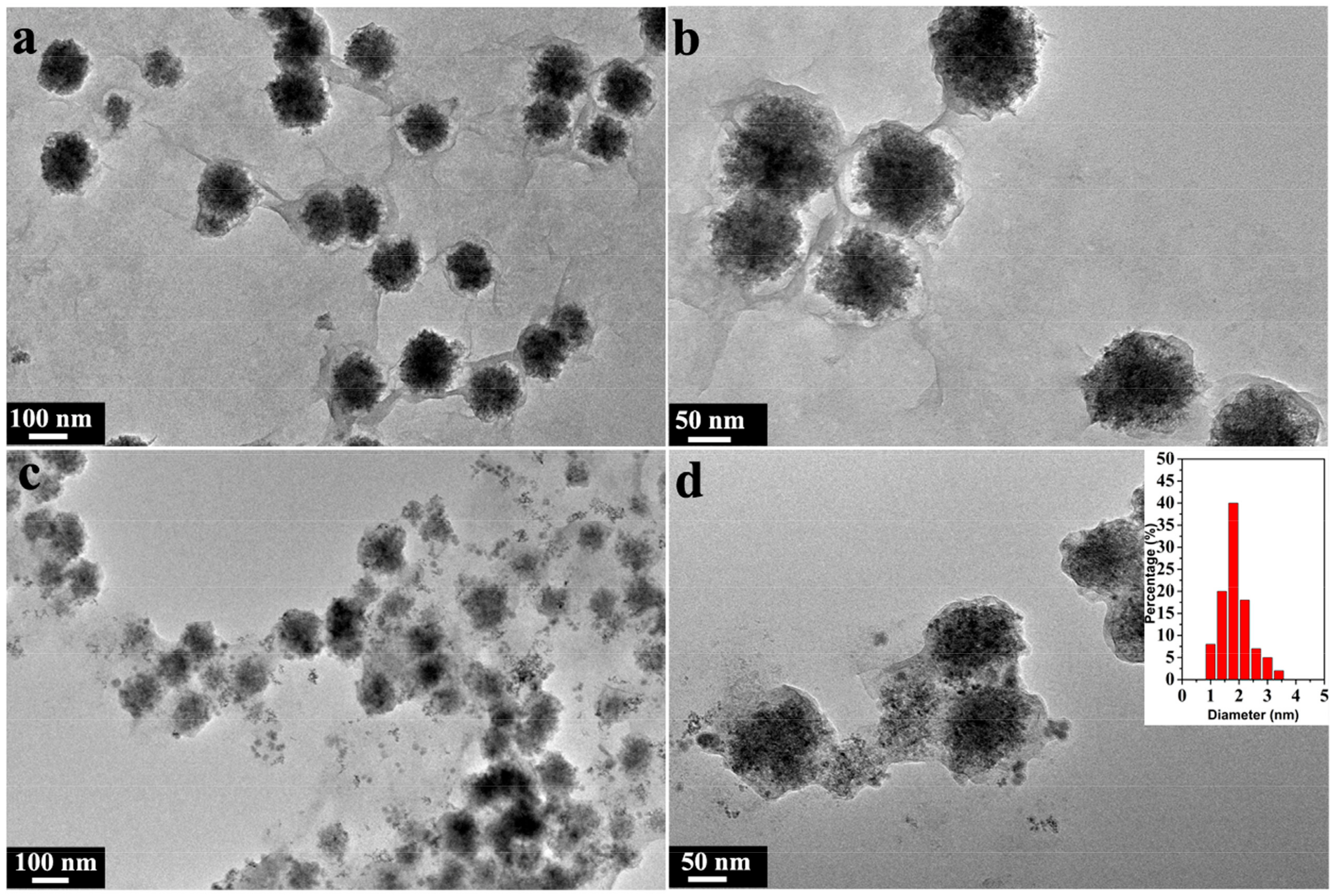
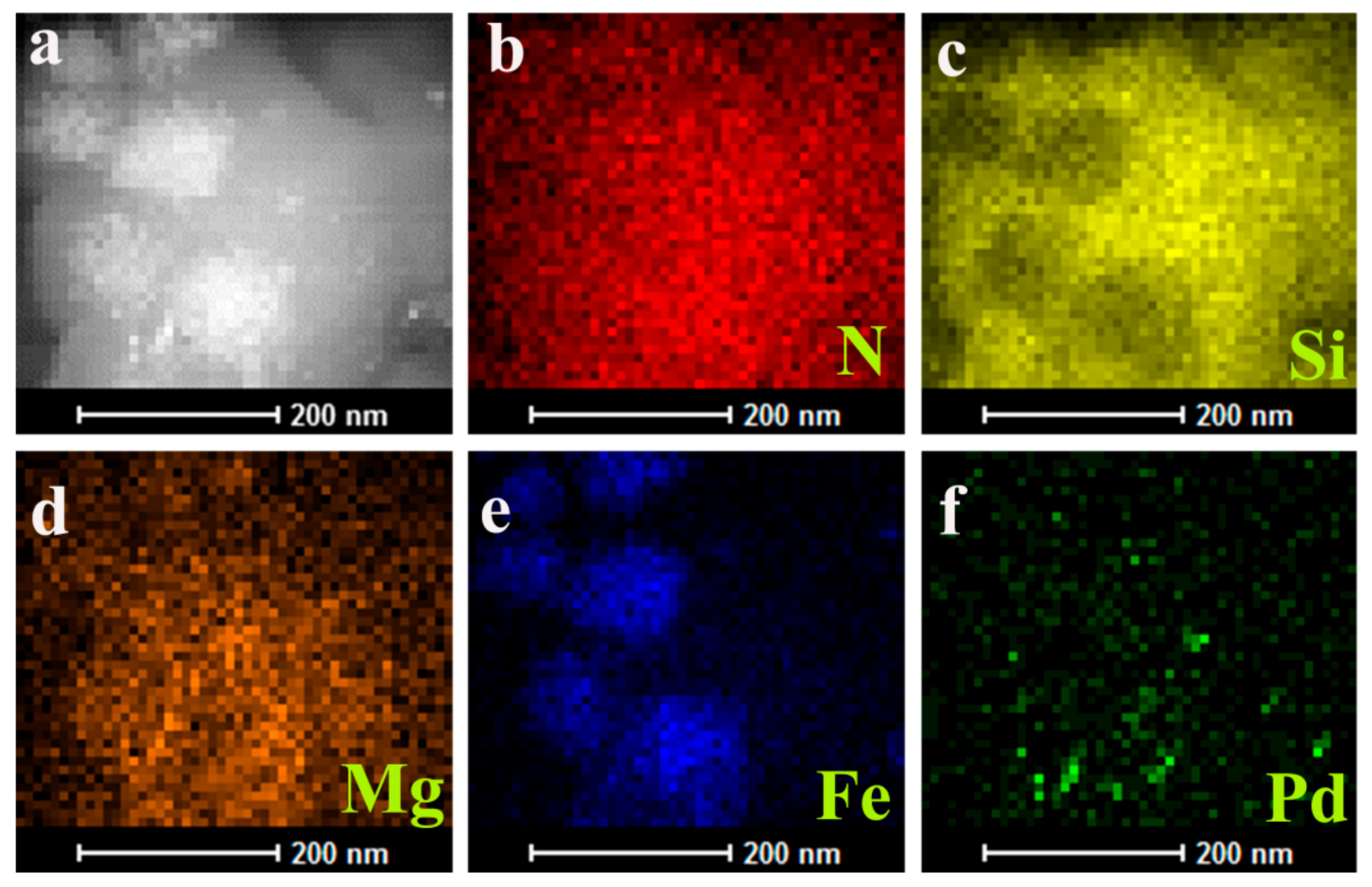
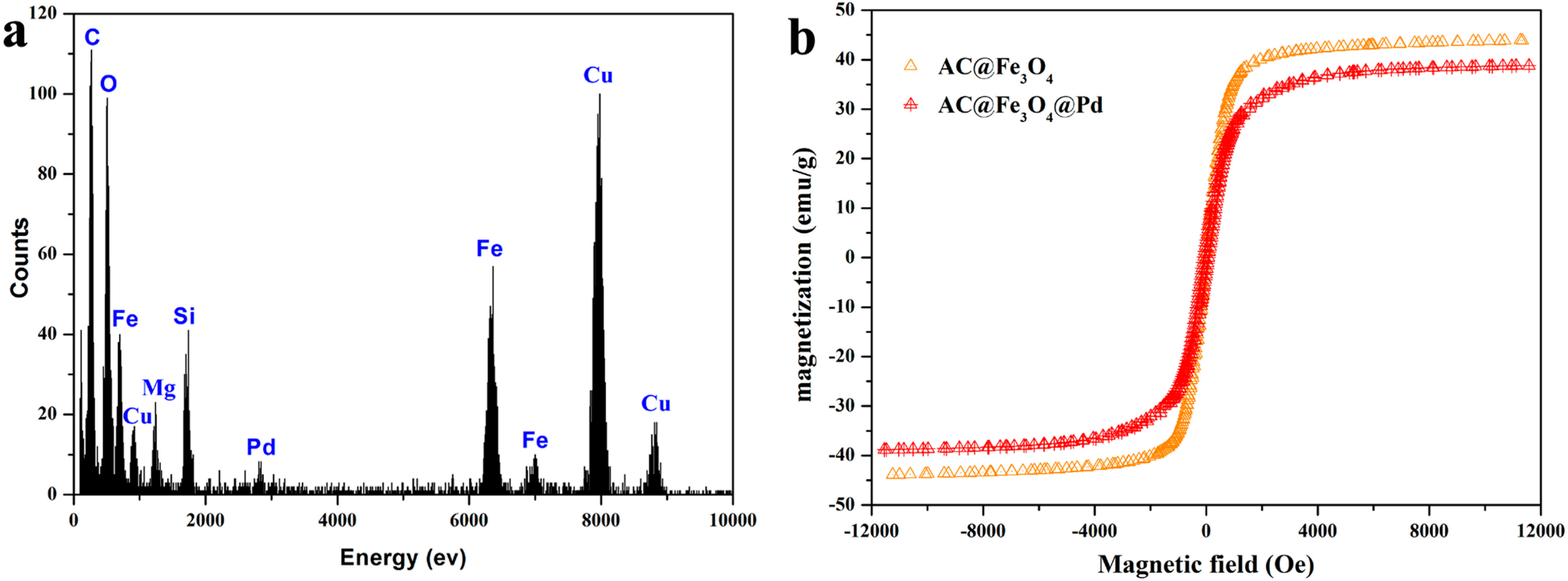
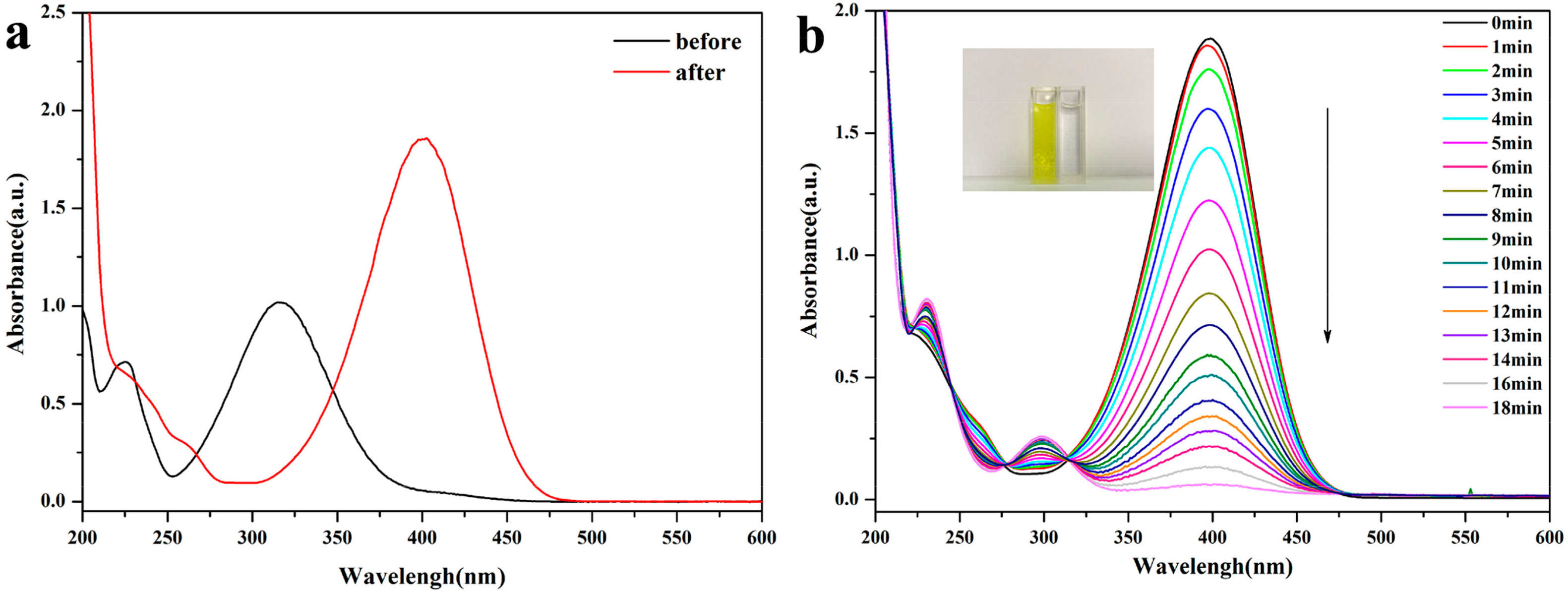
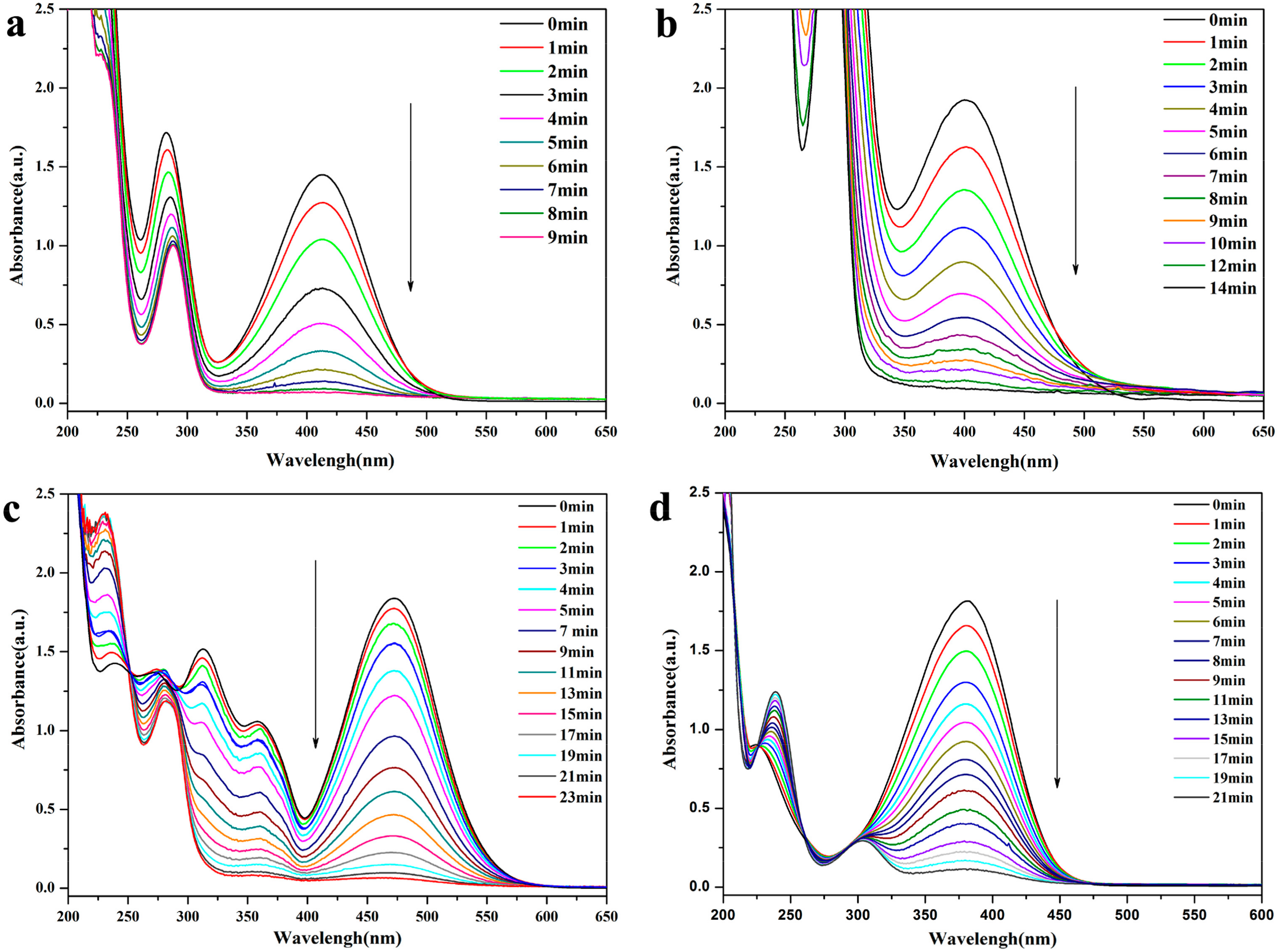
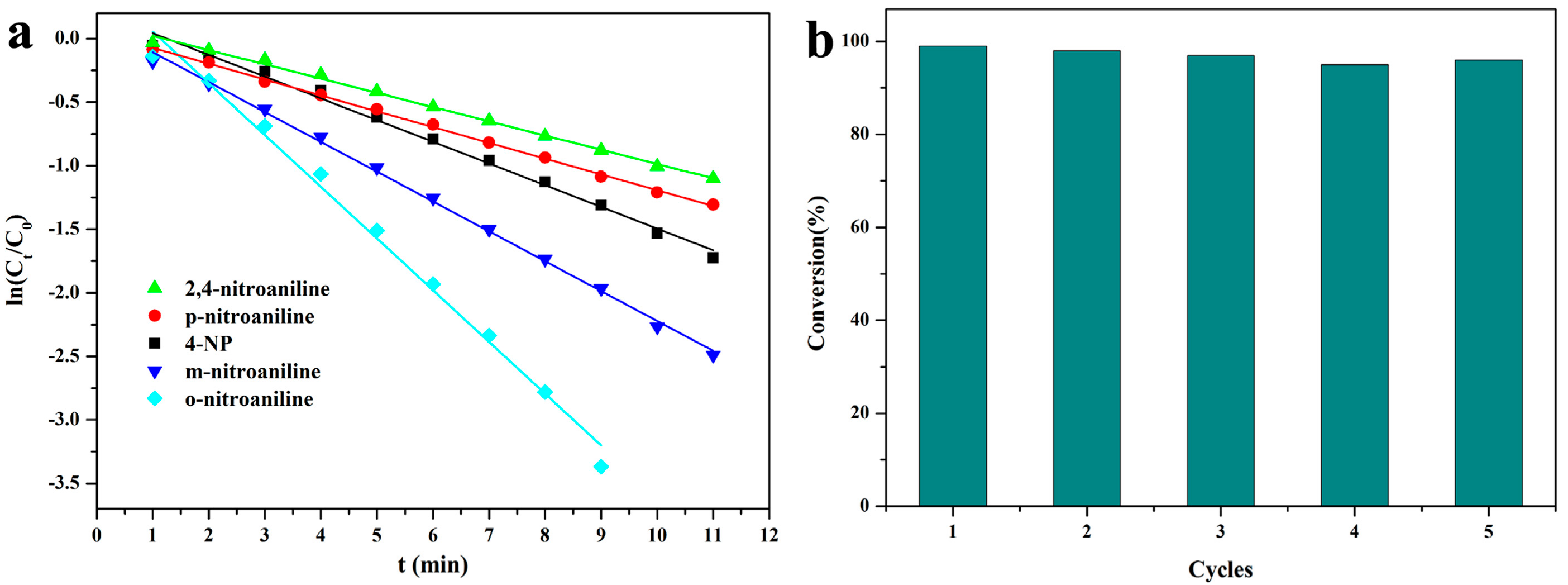
| Compound | Time/min | Rate Constant/min−1 |
|---|---|---|
| p-Nitroaniline | 21 | 0.124 |
| m-Nitroaniline | 14 | 0.235 |
| o-Nitroaniline | 9 | 0.407 |
| 2,4-Nitroaniline | 23 | 0.119 |
| p-Nitrolpenol | 18 | 0.171 |
| Catalysts | Catalysts Dosage (mg) | Pd Loading (wt %) | NaBH4 Dosage | K Value (min−1) | K/mPd Value (min−1 mg−1) a | References |
|---|---|---|---|---|---|---|
| Mesoporous Pd leaves | 0.25 | Nearly 100 | 0.3 mL × 0.1 M | 0.49 | 1.96 | 38 |
| Pd/rGS | 1.0 | 0.5 | 0.1 mL × 0.01 M | 0.141 | 28.2 | 39 |
| Pd/rGS | 0.5 | 7.5 | 1.0 mL × 0.1 M | 0.27 | 7.2 | 40 |
| FexOy/Pd@mSiO2 | 0.1 | 1.9 | 0.5 mL × 0.26 M | 0.096 | 50.53 | 41 |
| AC@Fe3O4@Pd | 0.014 | 3.6 | 0.08 × 1.2 M | 0.171 | 339.29 | Here |
© 2018 by the authors. Licensee MDPI, Basel, Switzerland. This article is an open access article distributed under the terms and conditions of the Creative Commons Attribution (CC BY) license (http://creativecommons.org/licenses/by/4.0/).
Share and Cite
Jia, L.; Zhang, W.; Xu, J.; Cao, J.; Xu, Z.; Wang, Y. Facile Fabrication of Highly Active Magnetic Aminoclay Supported Palladium Nanoparticles for the Room Temperature Catalytic Reduction of Nitrophenol and Nitroanilines. Nanomaterials 2018, 8, 409. https://doi.org/10.3390/nano8060409
Jia L, Zhang W, Xu J, Cao J, Xu Z, Wang Y. Facile Fabrication of Highly Active Magnetic Aminoclay Supported Palladium Nanoparticles for the Room Temperature Catalytic Reduction of Nitrophenol and Nitroanilines. Nanomaterials. 2018; 8(6):409. https://doi.org/10.3390/nano8060409
Chicago/Turabian StyleJia, Lei, Wensheng Zhang, Jun Xu, Jianliang Cao, Zhouqing Xu, and Yan Wang. 2018. "Facile Fabrication of Highly Active Magnetic Aminoclay Supported Palladium Nanoparticles for the Room Temperature Catalytic Reduction of Nitrophenol and Nitroanilines" Nanomaterials 8, no. 6: 409. https://doi.org/10.3390/nano8060409
APA StyleJia, L., Zhang, W., Xu, J., Cao, J., Xu, Z., & Wang, Y. (2018). Facile Fabrication of Highly Active Magnetic Aminoclay Supported Palladium Nanoparticles for the Room Temperature Catalytic Reduction of Nitrophenol and Nitroanilines. Nanomaterials, 8(6), 409. https://doi.org/10.3390/nano8060409







